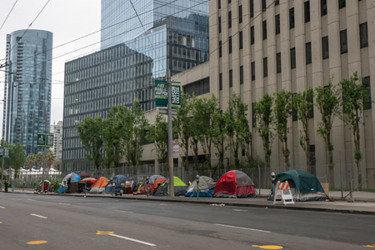Can JP Morgan Help San Francisco?

By Matthew Pillar, Editor, Bioprocess Online

JP Morgan Healthcare Conference first timer here. I started covering biotech right before the pandemic hit, so this month’s 41st annual effort at the show was my first chance to be there in person.
My time in San Francisco for Bioprocess Online and the Business of Biotech podcast was well-spent. I recorded a 5-part miniseries for the podcast with some great people representing companies doing fascinating work – namely Sangamo Therapeutics, Bolt Biotherapeutics, Oncolytics, Tessera, and Elixirgen. Keep an eye out for that miniseries here, starting very soon. I interviewed several other execs doing fancy things with large molecules for patients in need, made plans for many more stories and podcasts, and shook hands with dozens of people I’d only ever met on Zoom and Teams. Cost of a few days in San Francisco at its most expensive aside, it would be tough to be that efficient without the show, even virtually.
The reflection I’m offering here, however, isn’t about which pitch decks and clinical progress warrant the most investment attention or who struck the smartest deals around the JPM news cycle. It’s about the raw spectacle of unfathomable money descending on a city full of people who need help.
JPM San Fran: Where Health And Wealth Meet Squalor And Destitution
I walked slightly more than 21 miles of San Francisco’s rain-soaked streets covering my appointments during JPM week. Most of that walking skirted the Financial District, where the city’s higher-end hotels were hosting the week’s events sponsored by billion-dollar companies, giant law firms, and big health tech investment funds. Evenings brought receptions and mixers, those demanding longer walks to smaller venues scattered across Chinatown, the Tenderloin, and SoMa districts.
On those walks, I brushed elbows with men and women in Bergdorf Goodman and Brioni. Side-by-side, we stepped off sidewalks and into streets to make our way around full city blocks lined with the boxes and tents that thousands of San Franciscans call their homes. The city’s homeless population is the sixth highest in the nation. At 261 homeless people per 100,000 residents, it’s among the top ten per capita.
On my walks, I saw people in tattered clothes urinating on the sidewalk. I saw the blight of the opioid epidemic in broad daylight. In 21 miles of walking, I saw no fewer than half a dozen addicts in the process of inhaling or injecting illicit drugs. Just as many asked me for money, their voices and expressions pained and panging. Drug overdose is the leading cause of death for homeless people in San Francisco, where overdose deaths in general more than quadrupled over ten years, from 13 per 100,000 people in 2010 to 49 per 100,000 in 2020. It’s estimated that 50% of the city’s homeless population struggles with drug addiction.
Does JPM Help San Fran Beyond The Financial District?
I’ve been to a lot of cities where homelessness and illegal drugs are a problem, but I haven’t seen either like I saw them in San Francisco. And I haven’t seen them so starkly juxtaposed with the fortunes represented by the people and companies who descend there for a week of dealmaking each January during the JP Morgan Healthcare Conference. The spectacle of these diametrical poles was startling and disturbing. It begged the question, is the collective JP Morgan Healthcare Conference – the organization that runs it, those that fund it, the individuals who attend and occupy it, the myriad communities that comprise JPM Week – doing anything to improve the lives of people languishing in the city on which it descends?
Back when I covered the retail technology space, I regularly attended an annual conference hosted by a powerful industry association and lobbying group. Each year, the conference was held in a different large city, and each year, conference organizers and sponsors worked in partnership with organizations like the USS Foundation, a non-profit organization dedicated to helping underprivileged children, to host a large golf tournament. Proceeds from the tournament went directly to programs for underprivileged kids in the conference’s host city. It was a well-attended networking event that raised a lot of money for kids in need.
I’m not suggesting that throwing a golf tournament during a January San Francisco monsoon is a good idea, but it’s exemplary of the kind of cause-driven, event-specific philanthropy I’m wondering about. Does something like this exist around JPM Week that would directly benefit the 8,000 un-homed and 4,000 homeless and addicted inhabitants of San Francisco? Are there resources I can share with members of the Life Science Connect, Bioprocess Online, and Business of Biotech communities who’d like to help? If you’re aware of efforts to infuse some philanthropic or charitable effort into San Francisco’s homelessness and/or illicit drug problems, will you write to tell me about them? I’d like to know what the world’s toniest healthcare conference is doing to improve the health of its host city’s most vulnerable. I’d like to support it, and I’d like to spread the word. A little good deed might make us all feel better about those hotel prices. I'm at matt.pillar@lifescienceconnect.com.
